

Did you know that there is so much algae on Earth that algae produce most of the oxygen in the Earth’s atmosphere? Because of this, algae are very important plants for the Earth’s environment and its animals (including people). This is also one reason why algae are important for us to understand.
What exactly is algae? Algae are defined as simple plants that do not have flowers. There are types of algae that have many cells (such as seaweeds) and other types of algae that are only made of one single cell (like "diatoms"). Algae contain chlorophyll and make their own food using light in the process of photosynthesis. They produce oxygen during photosynthesis.
Algae lack true stems, roots, leaves, and vascular tissue. So, algae are non-vascular plants, which means they don't have tubes to transport water throughout the plant.

The picture above is an example of a multi-cellular (many-celled) form of algae called brown algae. Even though it looks like many vascular plants, it doesn't have tubes that transport water throughout the plant. Brown algae doesn't have roots that absorb water and nutrients (and transport them throughout the plant) either. Instead, the root-like structures of brown algae hold the plant in place. These are called "holdfasts" (makes sense, right?).
Another important part of brown algae are the "gas bladders." Though they might look kind of like flowers (or fruits), they are not flowers. The gas bladders are pods that contain (you guessed it!) gases (air). Gas bladders help keep the algae from sinking to the bottom of the ocean, where they would die due to lack of sunlight.
As you may have guessed, single-celled algae don't have all of these parts: stems, roots, leaves, and vascular tissues. (All of these parts are made of lots and lots of cells!)
Algae range in size from microscopic, single cells, to multi-cellular plants that are many meters in length.
Algae can be found in most habitats on Earth. But most algae can be found in either freshwater environments (for example, lakes or ponds) or marine environments (i.e., in oceans, seas, bays, or other waterways and nearby land surfaces).
Algae can also live in soil, on the bark of trees, and in many other moist places. The algae that live on the surfaces of ponds, lakes and oceans are an important food source for many animals.
Algae are extremely diverse: there are at least 30,000 different species of algae. The different species of algae respond differently to factors like light intensity/brightness, temperature, and the amount of carbon dioxide (CO2) dissolved in the water surrounding the algae.
Two major categories of algae are microscopic uni-cellular (single-celled) algae and larger multi-cellular (many-celled) algae. Let's take a closer look at each category.
Microscopic unicellular algae. Diatoms are one Class of uni-cellular (single-celled) algae. There are over 8,000 known species of diatoms, the most of any Class of algae. One species of diatoms is Chaetoceros muelleri.
As shown in the picture below, diatoms have transparent cell walls that you can see through. Diatoms are found on surfaces of both fresh water (like lakes) and salt water (oceans). Like all algae, diatoms use photosynthesis to make their food.
When diatoms die, their remains sink to the bottom of the water and form a layer. Shells of diatoms are a little bit rough. Because of this, people use the diatom shells to make toothpaste and other cleaning products.
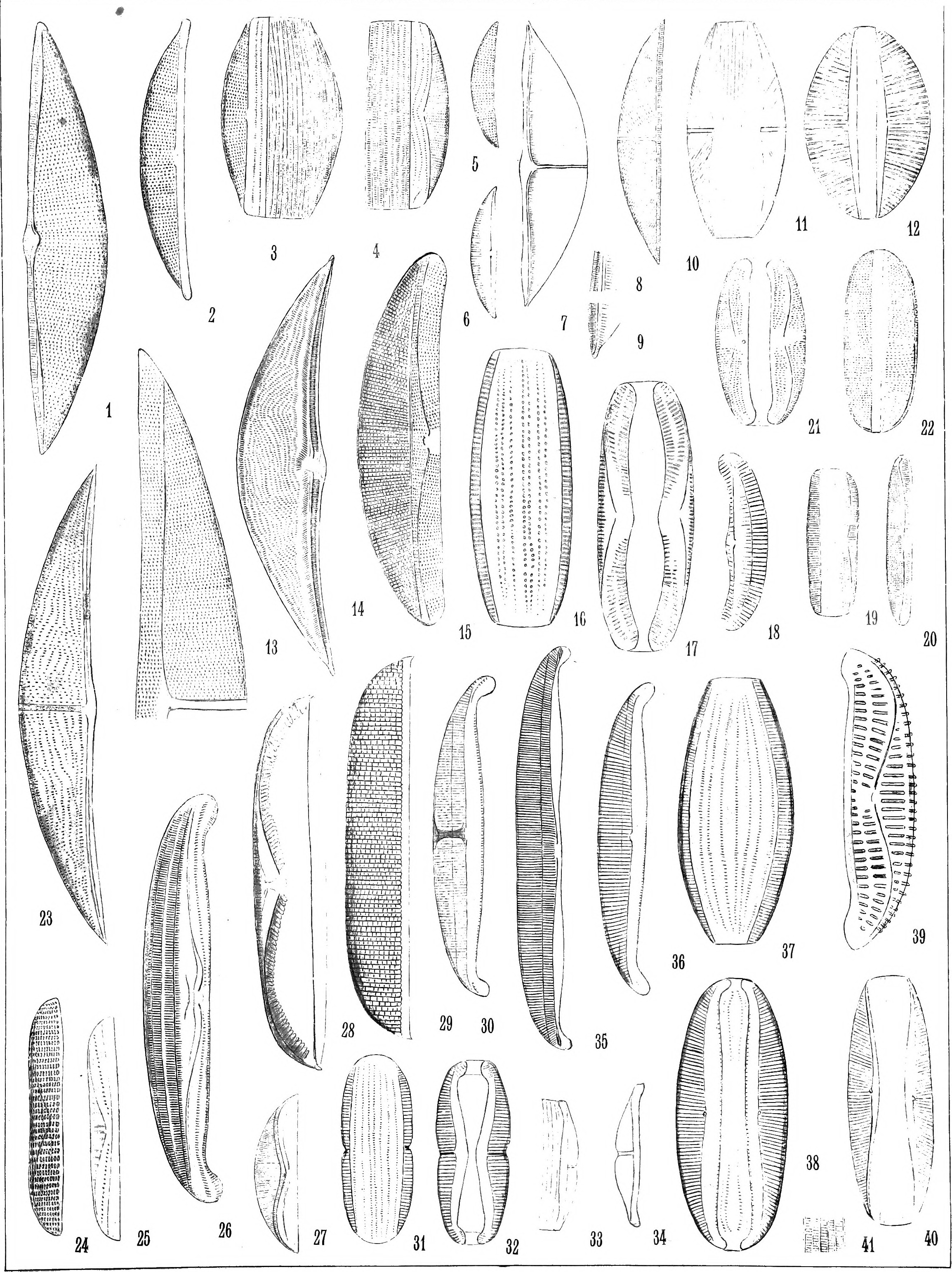
The picture above shows various species of diatoms, one Class of algae.
Multi-cellular algae. Brown algae is one type of multi-cellular algae that includes over 1,000 species. One type of brown algae is what some people may think of as seaweed. Despite its name, brown algae contains pigments (called fucoxanthin) that reflect yellow light; as a result, brown algae appears yellow-ish (see the picture below). Energy from the (non-yellow) wavelengths of light that these pigments absorb helps photosynthesis occur.
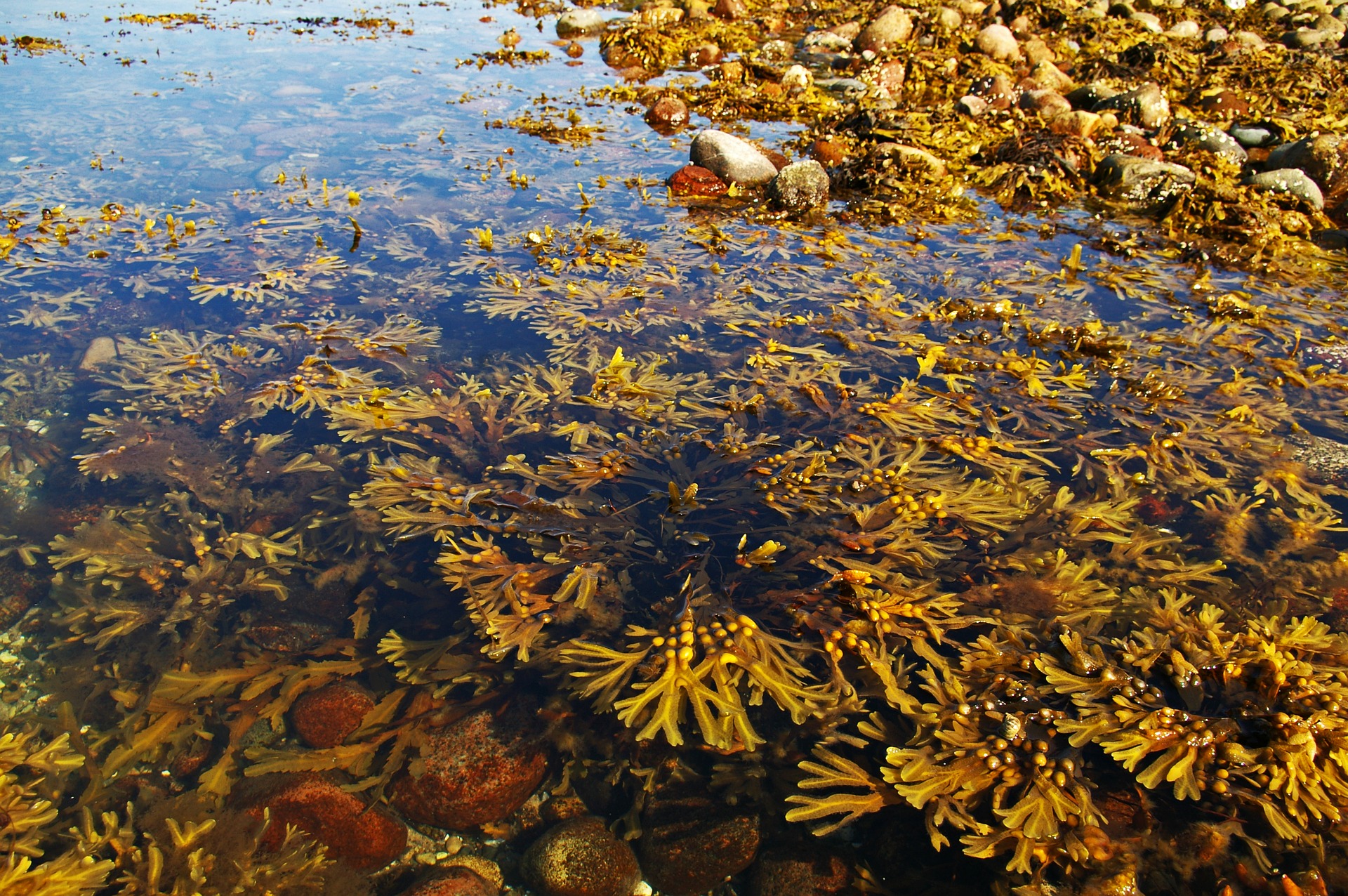
Brown algae—like that shown in the picture above—lives and thrives in cool, rocky waters, like off North American coasts of the Atlantic Ocean. Giant kelp is another type of brown algae, which lives off the coast of the Pacific Ocean. Harvested brown algae is used to make pudding and salad dressing.
Green algae (which includes the Phylum: Chlorophyta, which has about 4,500 known species) are
found on land around the bases of trees in moist areas. They are also found in both fresh and salt
water (near the surface).
Green algae can be either uni-cellular or multi-cellular. Seaweed is one example of multi-cellular green algae. Chlorella vulgaris and Chlorella sorokiniana are two species of uni-cellular green algae.
The algae is green due to the chlorophyll pigments it contains (like most plants). Green algae is also commonly found in swimming pools and fish tanks. The picture below shows a microscopic image of one type of green algae:
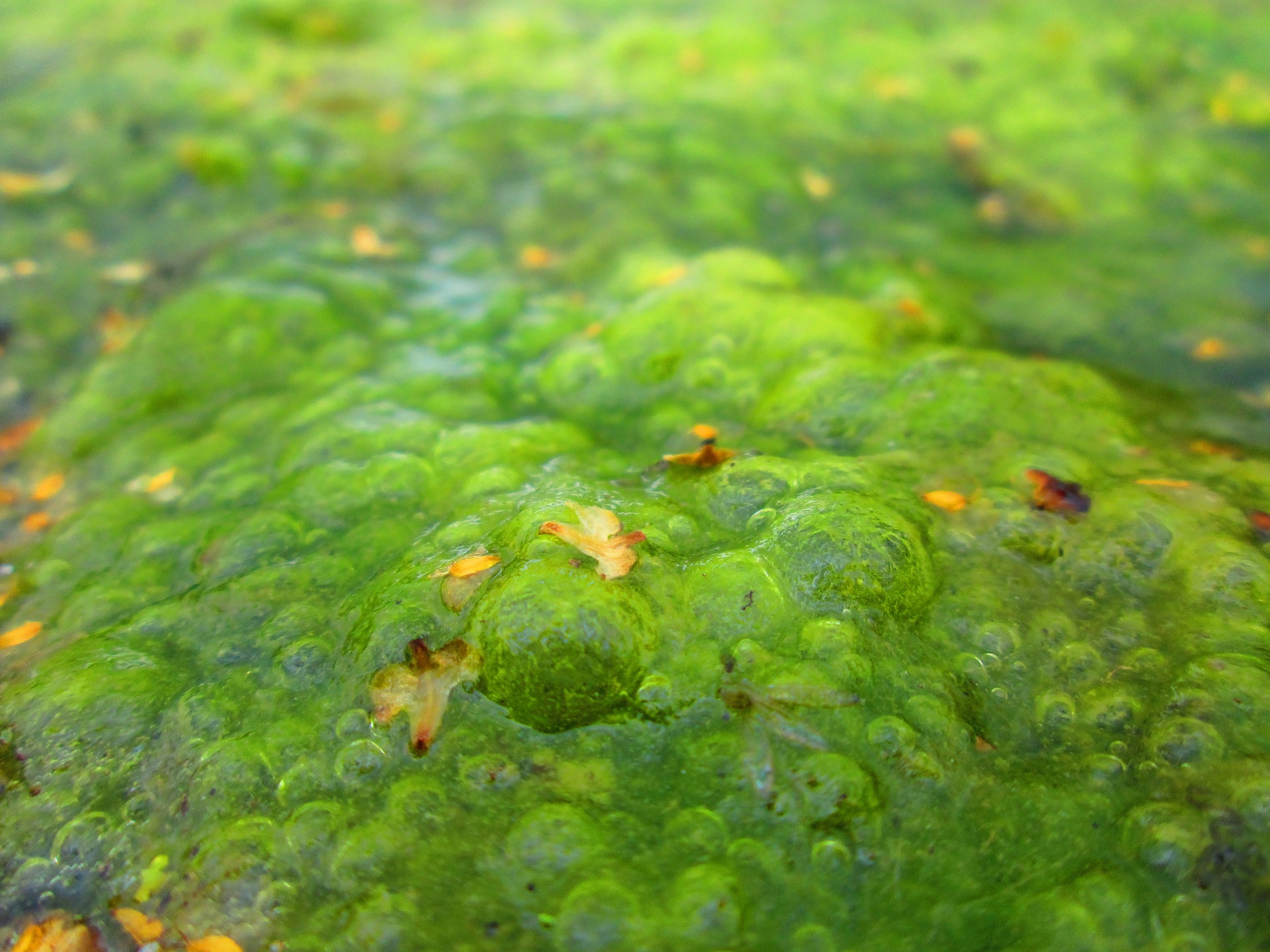
Red algae is another type of algae. Most red algae is multi-cellular. There are over 7,000 species of Red Algae. Red algae tend to live in deeper waters. The pigment found within red algae is able to absorb small amounts of light energy—mostly the higher-energy blue light that is able to travel farther through water than lower-energy light. This higher-energy blue light is used in photosynthesis. This type of algae appears red because it reflects (lower-energy) red light. But some species of “red” algae actually appear other colors, including orange, yellow, and pink (just not blue, because they absorb blue light).
The seaweed shown below is one example of multi-cellular red algae. Products made from red algae range from food (such as ice cream) to hair conditioners.

Problems with algae overgrowth
When the amount of nutrients in the water increases, algae can grow quickly. This can cause the water to turn in color to various shades such as brown, red, green and even become colorless, depending on the species of algae in “bloom”. These tides can become dangerous, because algae make toxins (poisons) when they are too densely packed together. The toxins released by algae collect in the bodies of the organisms (for example, small fish) eating the algae, which may kill them. If these organisms don't die from eating the concentrated algae, predators (for example, larger fish) who eat them may get sick.
Blooms can be found in both salt water and fresh water. Blooms in salt water are much harder to control because oceans are enormous.
The photo below shows an algae bloom in Lake Erie in the summer of 2019:
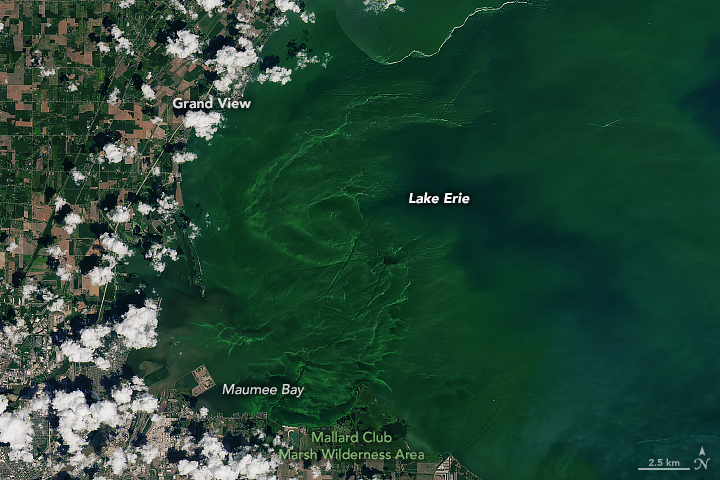
Humans are more likely to cause blooms in lakes and other freshwater bodies. This happens when farmers and other people over-fertilize soil; the extra nutrients in fertilizers can dissolve in drainage water and seep into nearby bodies of water. The excessive buildup of nutrients in bodies of water in turn causes the over-growth of algae. This process is called eutrophication (from Greek, "eu" is "good," and, remember that "troph" means "nourishing"). But in this case, the algae are getting too much nourishment and become a problem!
Next, we'll talk about some other factors that affect the growth rate of different algae species: temperature, light, and carbon dioxide.
Effects of temperature on algae growth. The rate that algae reproduces depends on the temperature of the water it's in. But, since different species of algae grow at different rates, we need to look at the relationship between temperature and algae growth rate for specific species of algae.
The graph below shows the growth rate of two species of "Chlorella" algae, Chlorella vulgaris and Chlorella NJ18, at different temperatures. As the temperature increases from 5°C (41°F), the growth rate increases up to 25-30°C. But when the temperature gets above 25-30°C (77-86°F), the growth rates actually start decreasing. In other words, when it's too hot, these algae don't grow as well. When it gets to 35°C (95°F), these algae completely stop growing.
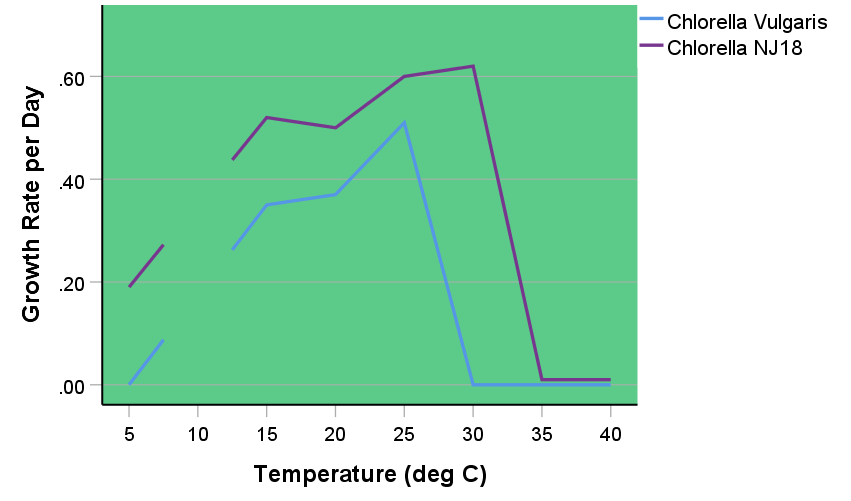
The graph below shows the growth rates of two other species of green algae: Chlorella sorokiniana and Picochlorum. As you can see from the y-axis on the graph, their growth rates are much higher than the growth rates of Chlorella vulgaris and Chlorella NJ18. In fact, the maximum growth rate for Chlorella sorokiniana is much higher than the three other species of green algae.
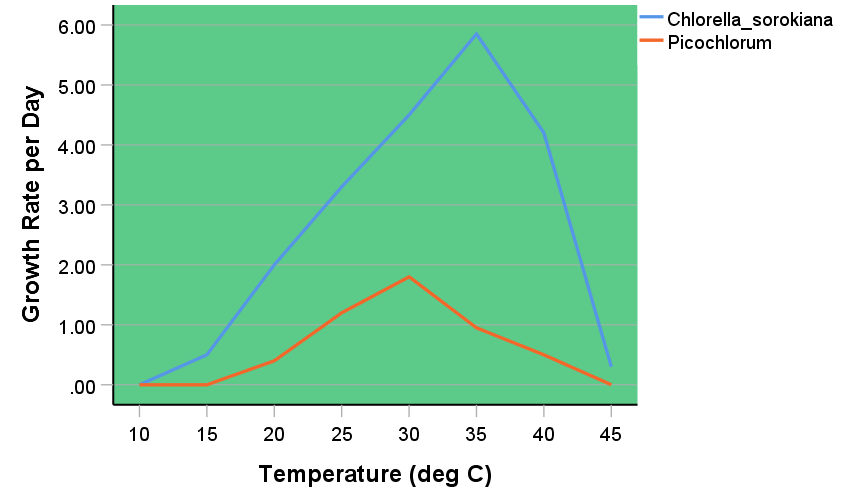
But what all 4 species of algae have in common is that they stop growing when it gets too hot (around 45°C or 113°F). This is because photosynthesis stops when it gets too hot.
Effects of light intensity on algae growth. The relationship between light intensity and the growth rate of another species of Chlorella algae, Chlorella sorokiniana algae, is curved. At 36°C (97°F), the growth rate is highest at around This is the brightness of full daylight but in indirect sun. As brightness increases above this level, Chlorella sorokiniana algae growth rates become slower.
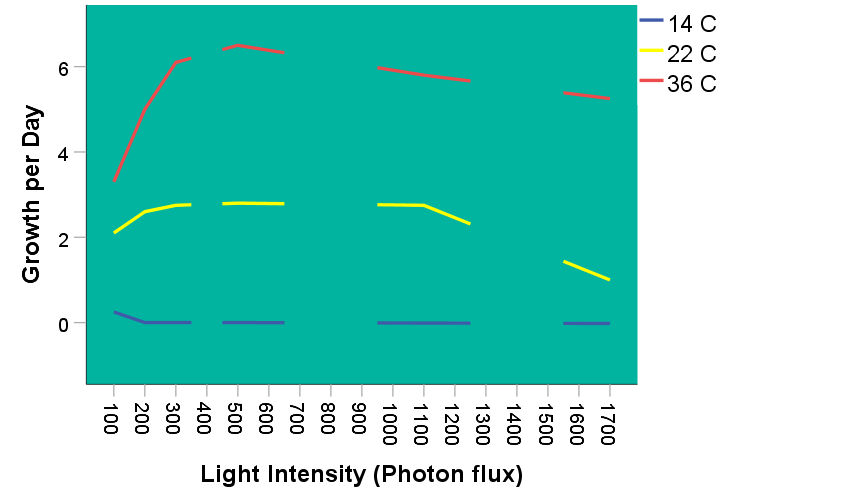
To get an idea of what different levels of brightness are, the figure below shows increasingly bright skies from left to right (and the corresponding brightness in photon flux). The sunlight is actually brighter than what's shown in these photos — especially the last photo below. This is because photos can't show the full brightness of the sun.
Relationship between light intensity (how bright the light is) and algae growth. The graph below show the relationship between the number of diatomic algae cells in millions (for the species Chaetoceros muelleri) and time (up to 7 days). Each different line shows the relationship for a different light intensity, from 0 lux (no light) to 2,500 lux (a medium-bright day).
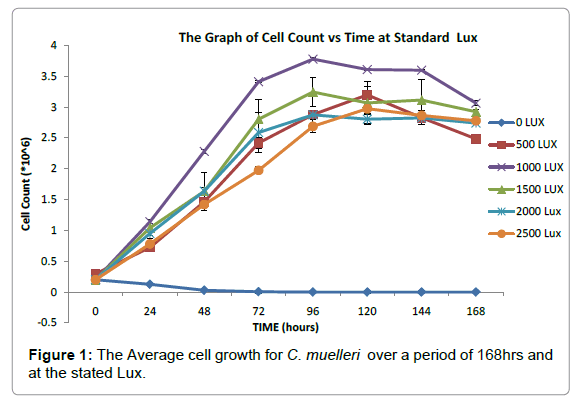
Effects of carbon dioxide on algae growth. As shown in the graph below, algae of the species Chlorella vulgaris grows more at higher than lower levels of CO2 dissolved in water. This is true both when the light intensity is at 39 photon flux and 176 photon flux.
